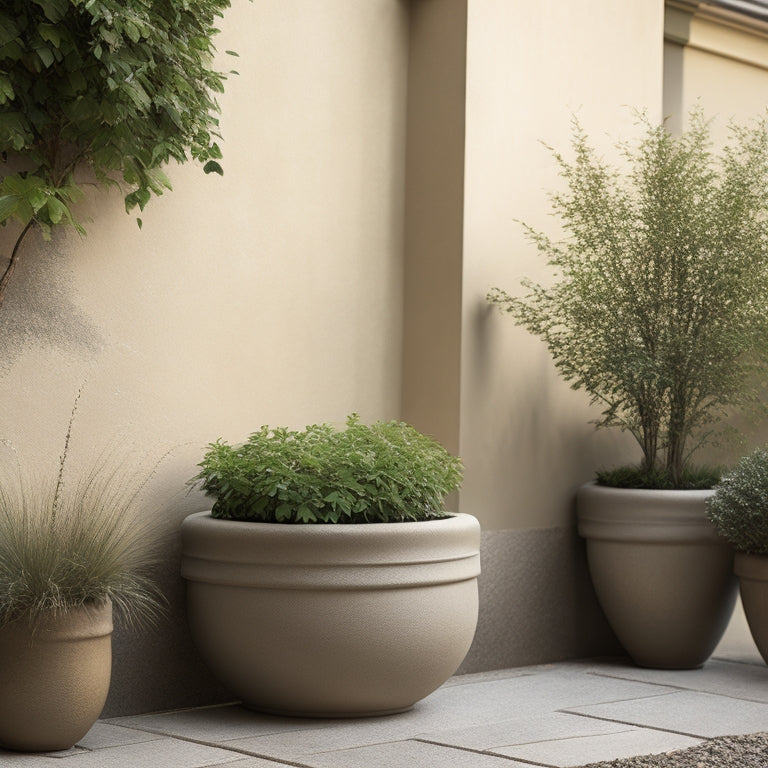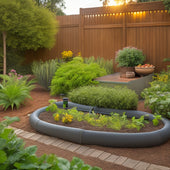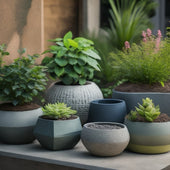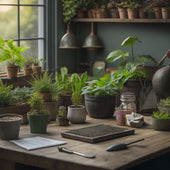
3 Simple Steps to Maintain Your Concrete Planters
Share
You can greatly extend the lifespan of your concrete planters by incorporating three essential maintenance tasks into your routine, tackling dirt buildup, harsh weather conditions, and structural damage in a proactive and decisive manner. Clean your planters regularly to prevent damaging substances from building up, using a soft-bristled brush or mild detergent to remove debris and stains. Next, protect your planters from extreme weather by insulating them with burlap or foam sheets and applying waterproof sealants. Finally, address cracks promptly by cleaning and filling them with concrete patching compound, and sealing the entire planter to prevent further damage - and that's just the foundation of a thorough maintenance plan.
Key Takeaways
• Establish a regular cleaning schedule to maintain planter integrity and prevent dirt buildup.
• Protect your planters from harsh weather by applying waterproof sealants and UV-resistant coatings.
• Inspect your planters regularly for cracks and address them promptly with concrete patching compound and sealer.
Clean Your Planters Regularly
Sweeping away debris and dirt from your concrete planters regularly prevents the buildup of damaging substances that can compromise their integrity.
You'll want to adopt a routine cleaning schedule to keep your planters in pristine condition. For ideal results, incorporate a combination of cleaning techniques into your maintenance frequency.
Start by gently sweeping away loose debris with a soft-bristled brush or a dry cloth. Next, mix a solution of mild detergent and warm water, and use a soft-bristled brush to scrub away stubborn stains and grime. Rinse your planters thoroughly with clean water to remove any soap residue.
For tougher stains, consider using a pressure washer set to a low pressure to avoid damaging the concrete. By cleaning your planters regularly, you'll prevent the buildup of harmful substances that can cause cracks, discoloration, and erosion.
Aim to clean your planters at least once a month, or more often if they're exposed to heavy use or harsh weather conditions.
Protect From Extreme Weather
Every year, harsh weather conditions like intense sunlight, freezing temperatures, and heavy rainfall can wreak havoc on your concrete planters, so it is vital to take proactive measures to shield them from the elements.
To protect your planters, consider using insulation techniques such as wrapping them with burlap or foam sheets to keep them warm during winter and cool during summer. You can also apply a waterproof sealant to prevent water from seeping into the planters and causing damage.
| Weather Condition | Protective Measure | Benefits |
|---|---|---|
| Intense Sunlight | Apply UV-resistant coating | Reduces fading and cracking |
| Freezing Temperatures | Insulate with foam sheets | Prevents water from freezing and expanding |
| Heavy Rainfall | Install drainage solutions | Prevents waterlogged soil and planter damage |
| Strong Winds | Secure planters with weights | Prevents tipping and overturning |
Seal and Repair Cracks
As cracks in your concrete planters begin to appear, you'll need to address them promptly to prevent water seepage and further damage.
Crack sealing is a vital step in maintaining your planters, and it's important to do it right. Start by cleaning the cracked area thoroughly with a wire brush to remove any dirt or debris.
Next, perform surface preparation by sanding the area to create a rough texture for the sealant to bond to. Apply a concrete patching compound to fill the crack, making sure to press it firmly into the gap.
Use a putty knife to smooth out the surface, feathering it out towards the edges. Allow the compound to dry completely before sealing the entire planter with a concrete sealer.
This will protect the concrete from further damage and guarantee your planters continue to thrive. By following these steps, you'll be able to effectively seal and repair cracks, extending the life of your concrete planters.
Frequently Asked Questions
Can I Use Concrete Planters for Indoor Plants?
You're considering using concrete planters for your indoor plants, but wonder if it's a good idea. The answer is yes, but with some caveats.
When selecting indoor plants, choose varieties that thrive in low-light conditions, as concrete can absorb moisture.
Guarantee proper drainage solutions, like adding a layer of small rocks or broken pottery, to prevent waterlogged soil.
With the right plant and setup, concrete planters can add a touch of industrial chic to your indoor space.
How Often Should I Replace the Soil in My Planters?
You'll want to replace the soil in your planters when its composition starts to degrade, typically every 1-2 years.
Pay attention to seasonal changes, as they can affect soil quality. During spring and summer, soil can become depleted from frequent watering, while winter's dry air can cause it to compact.
Monitor your plants' health and adjust your replacement schedule accordingly.
Fresh soil will guarantee your plants receive the necessary nutrients to thrive.
Are Concrete Planters Safe for Pets and Children?
Did you know that over 75% of American households own a pet?
As a responsible pet owner, you're right to wonder if your concrete planters are safe for your furry friends. The good news is that concrete planters are generally non-toxic and won't harm your pets if they accidentally ingest small amounts of concrete dust.
Similarly, for child safety, concrete planters are sturdy and won't topple over easily, making them a safe choice for homes with kids.
Can I Paint or Stain My Concrete Planters?
You're wondering if you can give your concrete planters a fresh new look. Absolutely, you can!
Painting and staining are great ways to enhance their appearance. For a bold look, try using painting techniques like stenciling or ombre. If you prefer a more subtle approach, consider staining options like acid staining or water-based stains.
Make sure to prep the surface properly and follow the manufacturer's instructions for a professional-looking finish. With a little creativity, you'll be amazed at the transformation!
How Long Do Concrete Planters Typically Last Outdoors?
You're wondering how long concrete planters typically last outdoors.
The answer depends on durability factors, such as the quality of the concrete mix, construction, and finishing techniques.
Weather resistance is also essential, as exposure to harsh elements can lead to degradation.
With proper care, a well-made concrete planter can last for 10 to 20 years or more, maintaining its structure and appearance despite the elements.
Conclusion
By following these 3 simple steps, you'll be able to enjoy your concrete planters for years to come.
Remember, regular cleaning will prevent dirt buildup, protecting from extreme weather will safeguard against damage, and sealing cracks will prevent water seepage.
For instance, take the example of the Smiths, who applied a waterproof sealant to their planters before a harsh winter, and were thrilled to find their plants thriving come spring.
Related Posts
-

Irrigation Solutions for Raised Bed Planters Made Easy
You can optimize your raised bed planters' irrigation system by understanding the complex interplay between soil type...
-

Irrigation Solutions for Raised Bed Planters Made Easy
You can optimize your raised bed planters' irrigation system by understanding the complex interplay between soil type...
-

Irrigation Solutions for Raised Bed Planters Made Easy
You can optimize your raised bed planters' irrigation system by understanding the complex interplay between soil type...
-

Irrigation Solutions for Raised Bed Planters Made Easy
You can optimize your raised bed planters' irrigation system by understanding the complex interplay between soil type...
-

Irrigation Solutions for Raised Bed Planters Made Easy
You can optimize your raised bed planters' irrigation system by understanding the complex interplay between soil type...
-

Irrigation Solutions for Raised Bed Planters Made Easy
You can optimize your raised bed planters' irrigation system by understanding the complex interplay between soil type...
-

Irrigation Solutions for Raised Bed Planters Made Easy
You can optimize your raised bed planters' irrigation system by understanding the complex interplay between soil type...
-

Irrigation Solutions for Raised Bed Planters Made Easy
You can optimize your raised bed planters' irrigation system by understanding the complex interplay between soil type...
-

Irrigation Solutions for Raised Bed Planters Made Easy
You can optimize your raised bed planters' irrigation system by understanding the complex interplay between soil type...
-

Irrigation Solutions for Raised Bed Planters Made Easy
You can optimize your raised bed planters' irrigation system by understanding the complex interplay between soil type...
-

Irrigation Solutions for Raised Bed Planters Made Easy
You can optimize your raised bed planters' irrigation system by understanding the complex interplay between soil type...
-

Irrigation Solutions for Raised Bed Planters Made Easy
You can optimize your raised bed planters' irrigation system by understanding the complex interplay between soil type...
-

Irrigation Solutions for Raised Bed Planters Made Easy
You can optimize your raised bed planters' irrigation system by understanding the complex interplay between soil type...
-

Irrigation Solutions for Raised Bed Planters Made Easy
You can optimize your raised bed planters' irrigation system by understanding the complex interplay between soil type...
-

Irrigation Solutions for Raised Bed Planters Made Easy
You can optimize your raised bed planters' irrigation system by understanding the complex interplay between soil type...
-

Irrigation Solutions for Raised Bed Planters Made Easy
You can optimize your raised bed planters' irrigation system by understanding the complex interplay between soil type...
-

Irrigation Solutions for Raised Bed Planters Made Easy
You can optimize your raised bed planters' irrigation system by understanding the complex interplay between soil type...
-

Irrigation Solutions for Raised Bed Planters Made Easy
You can optimize your raised bed planters' irrigation system by understanding the complex interplay between soil type...
-

Irrigation Solutions for Raised Bed Planters Made Easy
You can optimize your raised bed planters' irrigation system by understanding the complex interplay between soil type...
-

Irrigation Solutions for Raised Bed Planters Made Easy
You can optimize your raised bed planters' irrigation system by understanding the complex interplay between soil type...
-

Irrigation Solutions for Raised Bed Planters Made Easy
You can optimize your raised bed planters' irrigation system by understanding the complex interplay between soil type...
-

Irrigation Solutions for Raised Bed Planters Made Easy
You can optimize your raised bed planters' irrigation system by understanding the complex interplay between soil type...
-

Irrigation Solutions for Raised Bed Planters Made Easy
You can optimize your raised bed planters' irrigation system by understanding the complex interplay between soil type...
-

Irrigation Solutions for Raised Bed Planters Made Easy
You can optimize your raised bed planters' irrigation system by understanding the complex interplay between soil type...
-

Irrigation Solutions for Raised Bed Planters Made Easy
You can optimize your raised bed planters' irrigation system by understanding the complex interplay between soil type...
-

Irrigation Solutions for Raised Bed Planters Made Easy
You can optimize your raised bed planters' irrigation system by understanding the complex interplay between soil type...
-

Irrigation Solutions for Raised Bed Planters Made Easy
You can optimize your raised bed planters' irrigation system by understanding the complex interplay between soil type...
-

Irrigation Solutions for Raised Bed Planters Made Easy
You can optimize your raised bed planters' irrigation system by understanding the complex interplay between soil type...
-

5 Best DIY Planter Ideas to Upcycle Concrete
You're about to breathe new life into discarded concrete blocks by transforming them into functional and visually app...
-

5 Best DIY Planter Ideas to Upcycle Concrete
You're about to breathe new life into discarded concrete blocks by transforming them into functional and visually app...
-

5 Best DIY Planter Ideas to Upcycle Concrete
You're about to breathe new life into discarded concrete blocks by transforming them into functional and visually app...
-

5 Best DIY Planter Ideas to Upcycle Concrete
You're about to breathe new life into discarded concrete blocks by transforming them into functional and visually app...
-

5 Best DIY Planter Ideas to Upcycle Concrete
You're about to breathe new life into discarded concrete blocks by transforming them into functional and visually app...
-

5 Best DIY Planter Ideas to Upcycle Concrete
You're about to breathe new life into discarded concrete blocks by transforming them into functional and visually app...
-

5 Best DIY Planter Ideas to Upcycle Concrete
You're about to breathe new life into discarded concrete blocks by transforming them into functional and visually app...
-

5 Best DIY Planter Ideas to Upcycle Concrete
You're about to breathe new life into discarded concrete blocks by transforming them into functional and visually app...
-

5 Best DIY Planter Ideas to Upcycle Concrete
You're about to breathe new life into discarded concrete blocks by transforming them into functional and visually app...
-

5 Best DIY Planter Ideas to Upcycle Concrete
You're about to breathe new life into discarded concrete blocks by transforming them into functional and visually app...
-

5 Best DIY Planter Ideas to Upcycle Concrete
You're about to breathe new life into discarded concrete blocks by transforming them into functional and visually app...
-

5 Best DIY Planter Ideas to Upcycle Concrete
You're about to breathe new life into discarded concrete blocks by transforming them into functional and visually app...
-

5 Best DIY Planter Ideas to Upcycle Concrete
You're about to breathe new life into discarded concrete blocks by transforming them into functional and visually app...
-

5 Best DIY Planter Ideas to Upcycle Concrete
You're about to breathe new life into discarded concrete blocks by transforming them into functional and visually app...
-

5 Best DIY Planter Ideas to Upcycle Concrete
You're about to breathe new life into discarded concrete blocks by transforming them into functional and visually app...
-

5 Best DIY Planter Ideas to Upcycle Concrete
You're about to breathe new life into discarded concrete blocks by transforming them into functional and visually app...
-

5 Best DIY Planter Ideas to Upcycle Concrete
You're about to breathe new life into discarded concrete blocks by transforming them into functional and visually app...
-

5 Best DIY Planter Ideas to Upcycle Concrete
You're about to breathe new life into discarded concrete blocks by transforming them into functional and visually app...
-

Why Invest in Specialized Planter Tools
You'll greatly boost your gardening success and yields by leveraging specialized planter tools that cater to the uniq...
-

Why Invest in Specialized Planter Tools
You'll greatly boost your gardening success and yields by leveraging specialized planter tools that cater to the uniq...
-

Why Invest in Specialized Planter Tools
You'll greatly boost your gardening success and yields by leveraging specialized planter tools that cater to the uniq...
-

Why Invest in Specialized Planter Tools
You'll greatly boost your gardening success and yields by leveraging specialized planter tools that cater to the uniq...
-

Why Invest in Specialized Planter Tools
You'll greatly boost your gardening success and yields by leveraging specialized planter tools that cater to the uniq...
-

Why Invest in Specialized Planter Tools
You'll greatly boost your gardening success and yields by leveraging specialized planter tools that cater to the uniq...
-

Why Invest in Specialized Planter Tools
You'll greatly boost your gardening success and yields by leveraging specialized planter tools that cater to the uniq...
-

Why Invest in Specialized Planter Tools
You'll greatly boost your gardening success and yields by leveraging specialized planter tools that cater to the uniq...
-

Why Invest in Specialized Planter Tools
You'll greatly boost your gardening success and yields by leveraging specialized planter tools that cater to the uniq...
-

Why Invest in Specialized Planter Tools
You'll greatly boost your gardening success and yields by leveraging specialized planter tools that cater to the uniq...
-

Why Invest in Specialized Planter Tools
You'll greatly boost your gardening success and yields by leveraging specialized planter tools that cater to the uniq...
-

Why Invest in Specialized Planter Tools
You'll greatly boost your gardening success and yields by leveraging specialized planter tools that cater to the uniq...
-

Why Invest in Specialized Planter Tools
You'll greatly boost your gardening success and yields by leveraging specialized planter tools that cater to the uniq...
-

Why Invest in Specialized Planter Tools
You'll greatly boost your gardening success and yields by leveraging specialized planter tools that cater to the uniq...
-

Why Invest in Specialized Planter Tools
You'll greatly boost your gardening success and yields by leveraging specialized planter tools that cater to the uniq...
-

Why Invest in Specialized Planter Tools
You'll greatly boost your gardening success and yields by leveraging specialized planter tools that cater to the uniq...
-

Why Invest in Specialized Planter Tools
You'll greatly boost your gardening success and yields by leveraging specialized planter tools that cater to the uniq...
-

Why Invest in Specialized Planter Tools
You'll greatly boost your gardening success and yields by leveraging specialized planter tools that cater to the uniq...
-

Why Invest in Specialized Planter Tools
You'll greatly boost your gardening success and yields by leveraging specialized planter tools that cater to the uniq...
-

Why Invest in Specialized Planter Tools
You'll greatly boost your gardening success and yields by leveraging specialized planter tools that cater to the uniq...
-

Why Invest in Specialized Planter Tools
You'll greatly boost your gardening success and yields by leveraging specialized planter tools that cater to the uniq...
-

Why Invest in Specialized Planter Tools
You'll greatly boost your gardening success and yields by leveraging specialized planter tools that cater to the uniq...
-

Why Invest in Specialized Planter Tools
You'll greatly boost your gardening success and yields by leveraging specialized planter tools that cater to the uniq...
-

Why Invest in Specialized Planter Tools
You'll greatly boost your gardening success and yields by leveraging specialized planter tools that cater to the uniq...
-

Why Invest in Specialized Planter Tools
You'll greatly boost your gardening success and yields by leveraging specialized planter tools that cater to the uniq...


